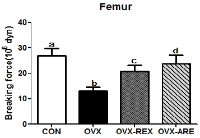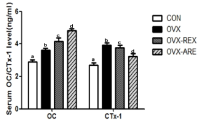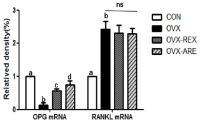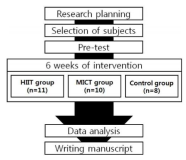
The primary purpose of this study was to investigate the effects of 6 weeks of high-intensity intermittent training (HIIT) and moderate-intensity continuous training (MICT) under relatively equal energy expenditure on body composition, aerobic capacity, cardiovascular function, insulin resistance, and blood lipid profiles in 20s overweight males. Twenty-nine males were randomized into one of the following groups: HIIT group (n=11), MICT group (n=10), and control group(n=8). Subjects in HIIT group completed 6 weeks of training for 25 min/sessions, three times/wk, and subjects in MICT group exercised for 33 min/session to equalize the energy expenditure with HIIT group. Subjects in control group were asked to maintain their normal life pattern during the same intervention period. Data were analyzed using two-way repeated measures ANOVA with post hoc test. Main results of the present study were as follows: 1) Body weight, BMI, fat mass, and WHR decreased significantly in HIIT group. 2) VO2max, VEmax, and time to exhaustion increased significantly in HIT group. 3) SBP decreased significantly in HIIT group and HRrest was tended to decrease in HIIT. 4) Fasting plasma insulin and HOMA-IR were tended to decrease in HIIT, but the changes failed to reach the statistically significant level. 5) HDL-C and TG were tended to improve in HIIT, but the changes failed to reach the statistically significant level. Results indicate that high intensity intermittent exercise training is more beneficial in aerobic capacity and cardiovascular function. It was also suggested that 6 weeks of aerobic exercise training in either high intensity intermittent or moderate intensity continuous was not sufficient enough to induce changes in body composition, insulin resistance and blood lipid profiles.

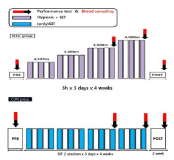
In this study, hypoxic exposure and training with regard to the current progress during the various models 'live and/or sleep high: train high' by way of 4 weeks in elite level tennis players. The experimental group which SITH(SIT with hypoxic) a 2,500m-4,000m to the graded elevation every 500m increased by the week five times a day, two times four weeks treated to a SIT (sprint interval training) and three hours of exposure in hypoxic chamber(simulated normobaric hypoxic). The CON(control) was conducted same period and methods without exposure to hypoxia that a SIT at sea level. As a results, the haematological variables were Hb and Hct compared Pre with the treatment at the end of 4,000 m(at 4 weeks) has been shown to significantly increased in both groups respectively(p<.05, p<.01; vs. Pre). Aerobic exercise capacity related variables that Time was SITH has been shown to significantly increased at 4,000 m(p<.05; vs. Pre). Also, VO2max was SITH has been showed increased in the same period a tendency(p=.072). Anaerobic exercise capacity related variables that PP(W) was both groups increased significantly at 4,000 m(p<.05; vs. Pre), and PP(W/kg) was CON group has been showed increased in the same altitude a tendency, whereas SITH group has been showed increased at 3,500m and 4,000m respectively(p<.05; vs. Pre). Therefore, this study was unlike previous studies with similar positive results as a follow-up study will be contribute to the attainment of a higher value.

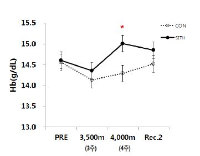
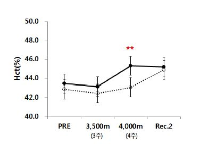
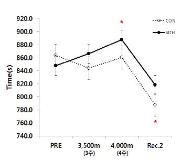
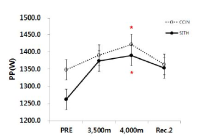
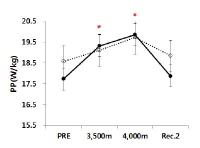
PURPOSE This study aimed to compare body composition, physical fitness, maximum muscle strength, and blood lactate concentration according to the level of aerobic capacity in Keirin cyclists. METHODS Forty-four Keirin cyclists participated in this study and were divided into three groups: the top 20% VO2max group (TG, n=9), the middle 20% VO2max group (MG, n=9), and the low 20% VO2max group (LG, n=9). The study measured body composition, physical fitness, maximum muscle strength, and blood lactate concentration in Keirin cyclists. Differences between groups were determined using one-way ANOVA analysis. RESULTS Body weight, percentage of body fat, and body mass index were significantly higher in the LG than in the TG and MG. The vertical jump and maximum muscle strength were significantly higher in the TG and MG than in the LG. Additionally, blood lactate concentrations immediately after exhaustive exercise and during the 5-minute recovery periods were higher in the LG than in the TG and MG. Moreover, the time to exhaustion, HRmax and maximum power were the highest in the TG. CONCLUSIONS Our findings suggest new information that levels of aerobic capacity in male Keirin cyclists might be a crucial predictor of cycling performance and recovery ability.

Purpose The purpose of this study is to emphasize the need for the establish and the use of altitude training center via examining exercise training method in natural or artificial altitude environment that is applied to various elite athletes in various advanced countries to maximize exercise performance and its effectiveness. Results Altitude training in natural or artificial altitude environment enhances aerobic and anaerobic exercise performance baesd on the hematological and nonhematological adaptations to hypoxic conditions. These altitude training methods can be classified into living high training high (LHTH), living high training low (LHTL), and living low training high (LLTH). LHTH (i.e., developed since the 1968 Mexico Olympics) and LHTL (i.e., developed in the 1990s by Levine and Stray-Gundersen) improve exercise performance via hematologic changes through erythropoiesis such as increased hemoglobin mass and erythrocyte volume. On the other hand, LLTH (i.e., has been developed variously since the 2000s) is composed continuous hypoxic training (CHT), intermittent hypoxic training (IHT) and repeated sprint training in hypoxia (RSH), and the altitude environment is constructed using a vacuum pump and a nitrogen generator. In general, LLTH method dose not induce hematological change in a short time within 3 hours. However, CHT and IHT enhance aerobic exercise capacity by improved exercise economy, supply and utilization of blood to tissues, capillary and mitochondrial densities, and oxidative enzyme activity through various biochemical and structural changes in skeletal muscle and cardiac muscle. RSH enhances anaerobic power and repetitive sprint performance by improving glycolytic enzyme, glucose transport, and pH control. In Korea, however, there are almost no facilities for altitude training that is applied to enhance athletic performance in advanced sports countries and recognition of the need for altitude training is also very poor. Conclusions Therefore, it is very urgent to develop altitude training for maximizing athletic performance in Korea and a lot of support and efforts are needed from the government and local governments.

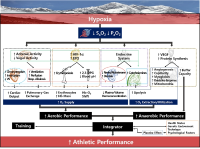


This study was aimed at investigating the effect of head-tilt angle on autonomic nerve modulation immediately after a single bout of exercise in twenty-three healthy young males(age 21.96 ± .4 yrs). Post-exercise HRV was measured on supine(SUP), -15°head-down tilt(HDT), and +15°head-up tilt(HUT) followed by 20 min aerobic exercise with moderate intensity(40% of VO2max). As results, heart rate recovery during post-exercise on each tilt angle(SUP vs. HDT vs. HUT) had no significant difference(p> .05). Also, there were no significant difference in time and nonlinear domain index of HRV. On spectral analysis; however, frequency domain index(HF, LF/HF ratio, HF/TP ratio, HF nu, LF nu) had significant difference(p< .05) on each tilt angle at recovery. Especially, PNS reactivation index (HF, HF/TP ratio, HF nu) had significant increase on HDT compared to HUT(p<. 05) while SNS activation index (LF/HF ratio, LF nu) had significant decrease on HDT compared to HUT(p<. 05). Furthermore, there were significant interaction between recovery time elapsed and each tilt angle (except for HF/TP ratio). In conclusion, -15°head-down tilt promotes the effective cardiac vagus nerve reactivation immediately after a single bout of aerobic exercise.


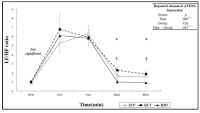
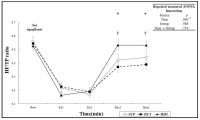

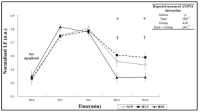
Purpose The valuable impacts of exercise-intervention in diverse type of cancer patients were rationally well-prescribed, though many experimental and review researches already performed in this fields. Generally, cancer-related fatigue and pain remains one of the most prevalent problems for cancer populations. Therefore, exercise has become increasingly significant in cancer prevention and progression. The purpose of this recent study was to analyze the combined exercise program on cancer-related fatigue, pain, quality of life and cancer prognosis in diverse type of cancer patients. This study analyses the safety and feasibility of exercise intervention in diverse stages of cancer patients such as early stage, advanced stage and even metastatic periods in cancer populations. we also wanted to know the impacts of dose-response trial of aerobic and resistance exercise on quality of life in cancer survivors. Methods we conducted a comprehensive PubMed/MEDILINE electronic database from Jan 2015 to August 2020. The reference lists of eligible experimental research articles and relevant systemic review articles were checked. Inclusion criteria were adult cancer survivors from randomized controlled trials performing well-tailored exercise intervention programs to diverse type of cancer patients, Using predefined search items ‘exercise-intervention, cancer & immunology’. Based on reference search, more than 100 articles were identified whereas 30 research papers met the inclusion criteria and were well connected with exercise-intervention and cancer progression. we analyzed the connections between physical exercise and cancer intervention in the main text. Results Moderate to vigorous exercise (aerobic and resistance exercise) revealed to decreased level of cancer-related fatigue, pain, and cancer-related symptoms, however increased level of sleep quality, activities of daily living, exercise performance and health- related quality of life. Exercise intervention reduced pro-inflammatory markers and oxidative stress as well as insomnia, fatigue, pain symptoms whereas it enhanced the antioxidant systems and immune functions. In addition, home-based aerobic physical exercise might enhance muscular strength and quality of life in many types of cancer survivors. Psychological intervention also effective for reducing cancer-related fatigue and pain during and after cancer treatment. they might be the much better intervention than available pharmaceutical options. we believe that it is the related mechanisms of immune cell mobilization and activation such as NK cells which is induced by the activation of sympathetic system during and after physical exercise. Conclusion According to the aforementioned results, it was concluded that implementation of exercise intervention appear to be the best non-pharmaceutical interventions for cancer populations, and also revealed to be safe and feasible in early and advanced stages, although not in the metastatic periods. Sometimes, psychological intervention such as mindfulness-based stress reduction (MBSR) might be useful in reducing anxiety, depression, fatigue, pain and enhancing quality of life, quality of sleep for cancer populations. we can conclude, exercise-intervention might not just be prevention effect but might be therapeutics, however more studies are urgently needed to confirm the exercise intervention on the NK-receptors activation and immune connection of cancer populations.

Purpose The purpose of this study was to investigate changes of the cardiovascular system by comparing heart rate (HR) and blood responses to exercise in younger and older adult dogs and to verify the value of dogs as aging model in exercise science research. Methods A total of 11 healthy beagles were divided into 2 groups according to age: younger adult dogs (1~2 years old, 7 animals) and older adult dogs (9~11 years old, 4 animals). Each animal exercised on the treadmill for 25 minutes, twice a week, and for 4 weeks. The exercise intensity was gradually increased by applying four different protocols. Resting HR, HR during exercise, and HR recovery time were determined as HR parameters. Biochemical analysis was performed on blood samples. The independent Student’s t-test and one-way ANOVA were used to analyze the mean difference of each variable. The associations between age and HR parameters were determined using Spearman‘s analysis. Results Older adult dogs showed higher HRs during rest and exercise than younger adult dogs. HR recovery time was significantly longer in older adult dogs than in younger adult dogs. A strong positive relationship was observed between beagles’ age and resting HR, HR during exercise, and HR recovery time, respectively. The heart rate response to the treadmill exercise was similar between the 1st week and 4th week in younger and older adult dogs. Exercise significantly reduced the white blood cell level in older adult dogs and increased the alkali phosphatase level in younger adult dogs. Conclusions The results of this study demonstrated that short-term treadmill exercise may have a positive effect on the aerobic capacity, inflammation, and bone formation, suggesting that dogs are valuable as aging model in exercise science research.

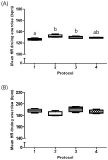
PURPOSE The purpose of this study was to examine the effect of visual color perception on autonomic nervous activity and exercise capacity in healthy male college students. METHODS The subjects who were healthy male college student (n=10) were participated in 4 visual colors using by randomized crossover; clear color group (CG), red color group (RG), blue color group (BG) and green color group (GG). All subjects wore goggles for five minutes prior to the exercise to adjust to color, and they did not take off goggles until recovery after exercise. Significant differences between groups were determined by two-way repeated measures ANOVA. RESULTS As a result of this study, the low frequency (LF) was significantly higher in RG than those in GG. But the high frequency (HF) was significant higher in BG compared to GG. Exercise capacity such as maximum strength, muscle endurance, reaction time, power, agility and aerobic performance did not differ significantly between all groups. CONCLUSIONS Therefore, our findings suggested that perception of the visual color might be change autonomic nervous activity, while don’t influence exercise capacity.

The purpose of this study was to explore the effects of 6-week treadmill exercise on inflammation and neuronal cell death in the hippocampus of intracerebroventricular (ICV) streptozotocin (STZ)-injected Alzheimer's disease (AD) rats. The experimental animals were divided into Sham-CON group (n=10), ICV-STZ CON group (n=10) and ICV-STZ TE group (n=10). The treadmill exercise was conducted for 30 minutes a day, 5 days a week, for 6 weeks. First, in a water maze test, it turned out that the time and distance of finding an escape platform significantly increased in the ICV-STZ CON group as compared to those in the Sham-CON group. In contrast, it turned out that the time and distance of finding the escape platform significantly decreased in the ICV-STZ TE group in which the treadmill exercise was carried out as compared to those in the ICV-STZ CON group. The expression of marker of astrocytes, Glial Fibrillary Acidic Protein (GFAP) increased in the ICV-STZ CON group as compared to that in the Sham-COM group, but that in the ICV-STZ TE group decreased as compared to that in the ICV-STZ CON group. Regarding inflammatory reactions, it turned out that the expressions of TNF-α, IL-1β, Lipocalin-2 and COX-2 increased in the ICV-STZ CON group as compared to those of the Sham-CON group, but it turned out that those of the ICV-STZ TE group decreased as compared to those of the ICV-STZ CON group. Regarding neuronal cell deaths, the expressions of caspase-3 and Bax increased in the ICV-STZ CON group as compared to the Sham-CON group, but it turned out that the expression of Bcl-2 decreased, and the neuronal cell deaths increased. However, it turned out that the neuronal cell deaths decreased in the ICV-STZ TE group in which the treadmill exercise was carried out as compared to that in the ICV-STZ CON group. Therefore, it turned out that the treadmill exercise showed positive effects on improving cognitive ability by reducing inflammatory reactions and inhibiting neuronal cell deaths in the rats with AD. In other words, aerobic exercise like treadmill exercise can be applied as an effective alternative to improve symptoms of AD.





Purpose Osteoporosis is a systemic metabolic bone disease characterized by gradual decrease of bone mass and damage of the bone microstructure. In particular, postmenopausal osteoporosis is the most common type in women after menopause. This study aims to investigate the effects of combined exercise training on bone mineral density (BMD) and OPG/RANKL mRNA levels in ovariectomized rats. Methods A total of 40 Sprague-Dawley female rats were randomly divided into four groups: (1) CON (sham-operation, n=10), (2) OVX (ovariectomy, n=10), (3) OVX-REX (ovariectomy-resistance exercise, n=10), and (4) OVX-ARE (ovariectomy-combined aerobic and resistance exercise, n=10). Combined exercise training was performed on a treadmill and ladder adapted to rats in alternate days (4 days/wk, for 12 wk). Results Compared to the OVX group, all exercise treatments increased BMD and bone breaking force(p<0.05). In the bone turnover markers, serum C-terminal telopeptides of type-1 collagen (CTX-1) was significantly decreased in the exercise groups compared with OVX group and osteocalcin (OC) level was increased in the exercise groups (p<0.05). Additionally, in the exercise groups, expression of OPG mRNA was significantly increased compared with OVX group (p<0.05), and RANKL mRNA was slightly decreased but no significant between groups. Furthermore, OVX-ARE group showed more effects than OVX-REX group. Conclusions These results suggest that combined exercise may be a more effective therapeutic strategy to prevent and delay postmenopausal osteoporosis than resistance-only training.

